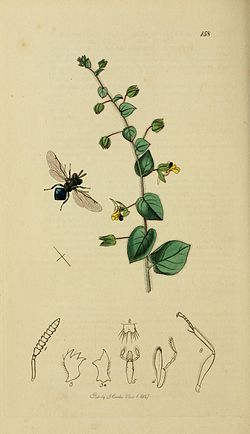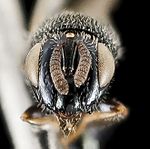Gropglanssteklar
| Den här artikeln har skapats av Lsjbot, ett program (en robot) för automatisk redigering. (2013-08) Artikeln kan innehålla fakta- eller språkfel, eller ett märkligt urval av fakta, källor eller bilder. Mallen kan avlägsnas efter en kontroll av innehållet (vidare information) |
| Gropglanssteklar | |
 | |
| Systematik | |
|---|---|
| Domän | Eukaryoter Eukaryota |
| Rike | Djur Animalia |
| Stam | Leddjur Arthropoda |
| Understam | Sexfotingar Hexapoda |
| Klass | Egentliga insekter Insecta |
| Ordning | Steklar Hymenoptera |
| Överfamilj | Glanssteklar Chalcidoidea |
| Familj | Gropglanssteklar Perilampidae |
| Vetenskapligt namn | |
| § Perilampidae | |
| Auktor | Förster, 1856 |
| Hitta fler artiklar om djur med | |
Gropglanssteklar (Perilampidae)[1] är en familj av steklar som beskrevs av Förster 1856. Enligt Catalogue of Life[1] ingår gropglanssteklar i överfamiljen glanssteklar, ordningen steklar, klassen egentliga insekter, fylumet leddjur och riket djur, men enligt Dyntaxa[2] är tillhörigheten istället ordningen steklar, klassen egentliga insekter, fylumet leddjur och riket djur. Enligt Catalogue of Life omfattar familjen Perilampidae 222 arter[1].
Kladogram enligt Catalogue of Life[1] och Dyntaxa[2]:
| glanssteklar |
| ||||||||||||||||||||||||||||||||||||||||||||||||||||||||||||||||||||||||||||||||||||||||||||||||||||||
Bildgalleri
Källor
- ^ [a b c d] Bisby F.A., Roskov Y.R., Orrell T.M., Nicolson D., Paglinawan L.E., Bailly N., Kirk P.M., Bourgoin T., Baillargeon G., Ouvrard D. (red.) (1 september 2011). ”Species 2000 & ITIS Catalogue of Life: 2011 Annual Checklist.”. Species 2000: Reading, UK. http://www.catalogueoflife.org/annual-checklist/2011/search/all/key/perilampidae/match/1. Läst 24 september 2012.
- ^ [a b] Dyntaxa Perilampidae
Externa länkar
 Wikimedia Commons har media som rör Gropglanssteklar.
Wikimedia Commons har media som rör Gropglanssteklar. Wikispecies har information om Perilampidae.
Wikispecies har information om Perilampidae.
Media som används på denna webbplats
Picture scanned and edited from Comstock, He himself had got it from previous authors, Smith and Ford
Perilampid Parasitic Wasp, Boonesboro, Maryland Washington County. A hyperparasite on other parasitic wasps...3mm
Canon Mark II 5D, Zerene Stacker, 65mm Canon MP-E 1-5X macro lens, Twin Macro Flash, F5.0, ISO 100, Shutter Speed 200Euperilampus triangularis , Maryland, Garrett County, July 2012 Perilampidae
A wee 2mm Perilampid from Hart-Miller Island collected by Gene Scarpulla and awaiting final determination.
13:47, 9 August 2014 (UTC)13:47, 9 August 2014 (UTC){{{{{{0}}}}}}13:47, 9 August 2014 (UTC)13:47, 9 August 2014 (UTC)
All photographs are public domain, feel free to download and use as you wish.
Photography Information: Canon Mark II 5D, Zerene Stacker, Stackshot Sled, 65mm Canon MP-E 1-5X macro lens, Twin Macro Flash in Styrofoam Cooler, F5.0, ISO 100, Shutter Speed 200
The murmuring of bees has ceased;
But murmuring of some
Posterior, prophetic,
Has simultaneous come,--
The lower metres of the year,
When nature's laugh is done,--
The Revelations of the book
Whose Genesis is June.
-Emily Dickinson
Want some Useful Links to the Techniques We Use? Well now here you go Citizen:
Basic USGSBIML set up:
www.youtube.com/watch?v=S-_yvIsucOY
USGSBIML Photoshopping Technique: Note that we now have added using the burn tool at 50% opacity set to shadows to clean up the halos that bleed into the black background from "hot" color sections of the picture.
www.youtube.com/watch?v=Bdmx_8zqvN4
PDF of Basic USGSBIML Photography Set Up:
ftp://ftpext.usgs.gov/pub/er/md/laurel/Droege/How%20to%20Take%20MacroPhotographs%20of%20Insects%20BIML%20Lab2.pdf
Google Hangout Demonstration of Techniques:
plus.google.com/events/c5569losvskrv2nu606ltof8odo
or
www.youtube.com/watch?v=4c15neFttoU
Excellent Technical Form on Stacking:
www.photomacrography.net/
Contact information: Sam Droege sdroege@usgs.gov
301 497 5840A wee 2mm Perilampid from Hart-Miller Island in the Chesapeake Bay collected by Gene Scarpulla and awaiting final deterimination.
13:47, 9 August 2014 (UTC)13:47, 9 August 2014 (UTC){{{{{{0}}}}}}13:47, 9 August 2014 (UTC)13:47, 9 August 2014 (UTC)
All photographs are public domain, feel free to download and use as you wish.
Photography Information: Canon Mark II 5D, Zerene Stacker, Stackshot Sled, 65mm Canon MP-E 1-5X macro lens, Twin Macro Flash in Styrofoam Cooler, F5.0, ISO 100, Shutter Speed 200
The murmuring of bees has ceased;
But murmuring of some
Posterior, prophetic,
Has simultaneous come,--
The lower metres of the year,
When nature's laugh is done,--
The Revelations of the book
Whose Genesis is June.
-Emily Dickinson
Want some Useful Links to the Techniques We Use? Well now here you go Citizen:
Basic USGSBIML set up:
www.youtube.com/watch?v=S-_yvIsucOY
USGSBIML Photoshopping Technique: Note that we now have added using the burn tool at 50% opacity set to shadows to clean up the halos that bleed into the black background from "hot" color sections of the picture.
www.youtube.com/watch?v=Bdmx_8zqvN4
PDF of Basic USGSBIML Photography Set Up:
ftp://ftpext.usgs.gov/pub/er/md/laurel/Droege/How%20to%20Take%20MacroPhotographs%20of%20Insects%20BIML%20Lab2.pdf
Google Hangout Demonstration of Techniques:
plus.google.com/events/c5569losvskrv2nu606ltof8odo
or
www.youtube.com/watch?v=4c15neFttoU
Excellent Technical Form on Stacking:
www.photomacrography.net/
Contact information: Sam Droege sdroege@usgs.gov
301 497 5840A wee 2mm Perilampid from Hart-Miller Island in the Chesapeake Bay collected by Gene Scarpulla and awaiting final deterimination.
13:47, 9 August 2014 (UTC)13:47, 9 August 2014 (UTC){{{{{{0}}}}}}13:47, 9 August 2014 (UTC)13:47, 9 August 2014 (UTC)
All photographs are public domain, feel free to download and use as you wish.
Photography Information: Canon Mark II 5D, Zerene Stacker, Stackshot Sled, 65mm Canon MP-E 1-5X macro lens, Twin Macro Flash in Styrofoam Cooler, F5.0, ISO 100, Shutter Speed 200
The murmuring of bees has ceased;
But murmuring of some
Posterior, prophetic,
Has simultaneous come,--
The lower metres of the year,
When nature's laugh is done,--
The Revelations of the book
Whose Genesis is June.
-Emily Dickinson
Want some Useful Links to the Techniques We Use? Well now here you go Citizen:
Basic USGSBIML set up:
www.youtube.com/watch?v=S-_yvIsucOY
USGSBIML Photoshopping Technique: Note that we now have added using the burn tool at 50% opacity set to shadows to clean up the halos that bleed into the black background from "hot" color sections of the picture.
www.youtube.com/watch?v=Bdmx_8zqvN4
PDF of Basic USGSBIML Photography Set Up:
ftp://ftpext.usgs.gov/pub/er/md/laurel/Droege/How%20to%20Take%20MacroPhotographs%20of%20Insects%20BIML%20Lab2.pdf
Google Hangout Demonstration of Techniques:
plus.google.com/events/c5569losvskrv2nu606ltof8odo
or
www.youtube.com/watch?v=4c15neFttoU
Excellent Technical Form on Stacking:
www.photomacrography.net/
Contact information: Sam Droege sdroege@usgs.gov
301 497 5840Robot icon
An illustration from British Entomology by John Curtis.Perilampus pallipes Valid name Perilampus ruficornis the Pale-footed Pallipes












